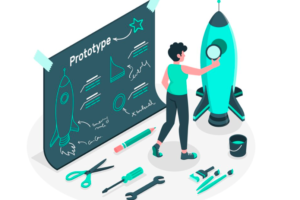Today, chatbots are all the current trends. In today’s consumer-centric online market, chats play different roles. It may be a problem-oriented customer interaction that responds to customer demands in a variety of industries in the form of a integrated SMS marketing platform to provide a smooth online shopping experience for a Smartphone user. It could even serves as a virtual assistant for home automation activities in a modern home.
What Is A Chatbot, And Its Relation To AI?
As its name suggests, a chatbot is simply a robot assistant with whom you can engage in a conversation to get what you need to do. The conversation can take place by text message or voice command. However, it is essential to understand that what makes software or a machine to communicate with a human being and perform simple or complex tasks is AI or “artificial intelligence” technology.
The AI can allow you to interact with a chatbot via a chat interface and take advantage of services ranging from daily hands-on activities to entertainment. Weather bots that inform and predict the local climate, news bots that can keep you up-to-date on your profession, and other service-related bots, such as personal financial bots, are examples of a chatbot. These robots can be found on many popular chat platforms such as Facebook Messenger, Telegram, Slack, etc.
Recent research has shown that human interaction with a chatbot is superior to social media applications. Smartphone users are now spending more time on messaging apps than on social media, which is a turning point. Messaging applications are the platforms of the future, and bots will be how users will access all types of services. “
This vast increase in chatbot popularity dates back to April 2016, when Facebook announced that it was providing developers with tools to create unique new chatbot features in Facebook Messenger.
Components Of Artificial Intelligence (AI)
Artificial intelligence uses two essential elements that help the chatbot get an accurate answer.
- Machine learning
Machine Learning is an algorithm that allows the chatbot to learn from the questions and data provided during the boot-up training. When a query is enabled, machine learning helps the mogul first monitor the conversation with the user and respond accordingly.
- NLP
Natural language processing is commonly called NLP, which helps robots understand and interpret information carefully. With NLP, you train your chatbot with several attempts that the user will write during the conversation, and these attempts will speed up the response to the query. NLP works with different intentions and entities.
Benefits Of Chatbots
It is evident that chatbots are popular in the consumer market and the CX (customer experience) field for several reasons, including:
- Ability to provide endless customer service 24/7
- Help provide a personalized customer experience by ensuring customer data to human agents to better measure a customer’s needs and requirements in real-time.
- Build a human relationship with customers that can promote brand loyalty, for example, by sending customers birthday greetings.
Chatbots have become a prominent business tool in the field of e-commerce. It has successfully duplicated a live shopping experience in the online store, a computer, a laptop, or a Smartphone. Chatbots greatly influence and increase online shopping, `loyalty. They are functional in the areas of digital commerce, banking, financing, and also serve to provide companies with research and generation data for potential customers (if you are interested in learning more about the role that the digital world has to play in customer experience, here is a great article you could check out). Chatbots have also helped improve business performance, for example, by reducing salaries and costs related to business performance or by increasing the productivity of administrative offices.
The Role Of The AI
The heart of AI’s effectiveness is machine learning and natural language processing (NLP). Although machine learning can be used to create different types of chatbot algorithms, NLP serves as a sensor for detecting and even mimicking human conversation patterns. Combined, these two essential factors of artificial intelligence can help a chatbot better understand human emotions and behaviors in real-time and thus offer an exceptional customer experience. For instance, in the housing industry, a real estate crm with features such as chatbots and improved customer service could prove crucial to the business owners and the growth of the venture.
But How Can the Entirety of Artificial Intelligence Be Utilized?
There is evidence that the actual effectiveness of AI lies in its ability to analyze data and make effective decisions in real-time. In a global online market, an artificial intelligence system can use many sources and data platforms, such as e-commerce, e-mail, social media, search functions, etc., to provide authentic solutions to Human requests.
Hence, the better the data management platform (DMP), the higher the efficiency of the AI chatbot. High-quality data leads to higher artificial intelligence, while inefficient data produces inefficient artificial intelligence. Also, a powerful artificial intelligence will drive its data to improve its self-learning ability. In turn, these self-learning data are regularly uploaded to the DPM to increase the artificial learning ability of artificial intelligence further.
Moreover, while talking about utilizing AI for work productivity, the use doesn’t only stop at chatbots. There can be other ways in which AI can improve a company’s workability for employees as well as customers. For instance, AI can be used to handle business operations like smart energy management, cybersecurity, CRM, internet and data research, digital assistance, etc. Another application of AI can be the gamification of a work process. Gamification means adding gaming elements to routine office work like points, leaderboards, badges and rewards. By using gamification for employee engagement, a company can ensure they achieve high workplace productivity and efficiency while providing employees proper compensation for their extra efforts.
In this way, businesses can accomplish higher goals and success rates by adopting and properly implementing the latest trends and technologies like artificial intelligence in a workplace.
Conclusion
Although robots do not replace human customers in consumer markets in the short term, they have proven to be extremely useful. In short, you can see that AI allows chatbots to continuously perform customer service activities without interference from human emotions or fatigue. Just follow the direction given by the data.





